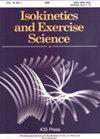短道速滑运动员臀大肌生物电活动斜率频率的不对称变化与经验的关系
IF 0.7
4区 医学
Q4 ENGINEERING, BIOMEDICAL
引用次数: 0
摘要
背景:在短道速滑中,滑行技术会导致臀大肌(GM)不对称疲劳。科学报告证实了肌肉疲劳与生物电活动斜率频率变化之间的关系。目的:研究在短道速滑精英赛中,运动经验是否能区分臀大肌原始肌电信号(EMG)斜率频率的非对称性变化,这种非对称性变化是否受到初级运动员和高级运动员经验差异的影响。方法:参加研究的是短道速滑国家队青少年组和老年组的精英运动员。使用 Biering-Sorensen 测试法对等长张力 GM 肌肉进行了测试。结果:研究证实,在短道速滑比赛中,少年组和老年组 GM 肌肉的斜坡频率 EMG 信号的不对称性存在差异(p⩽ 0.001)。高年级运动员右侧 GM 肌肉的斜率频率更高(p⩽ 0.002),而低年级运动员左侧 GM 肌肉的斜率频率更高(p⩽ 0.008)。组间分析表明,右侧 GM 肌肉(大三学生与大四学生)的斜率频率水平存在明显差异(p⩽ 0.001),这凸显了经验造成的不对称。结论:在右臀大肌的斜坡频率水平上,初学者与高龄者之间存在明显的统计学差异,这表明经验和滑冰技术会导致不对称。本文章由计算机程序翻译,如有差异,请以英文原文为准。
The relationship between asymmetry changes in the slope frequency of bioelectrical activity of the gluteus maximus muscles and experience in short track speed skating athletics
BACKGROUND: In short track speed skating, there is asymmetric fatigue of the gluteus maximus (GM) muscle resulting from the technique of skating. Scientific reports confirm the relationship between muscle fatigue and its change in the slope frequency of bioelectrical activity. OBJECTIVE: To investigate whether athletic experience in elite short track speed skating can distinguish the asymmetry change in slope frequency of the raw electromyographic signal (EMG) of the GM muscle, influenced by the disparity in experience between junior and senior athletes. METHODS: In the research, an elite group of short track speed skating national team athletes Junior and Senior, participated. Isometric tension GM muscle was tested using the Biering-Sorensen test. RESULTS: The study confirmed differences in the asymmetry of slope frequences EMG signal in GM muscle between juniors and seniors in short track speed skating (p⩽ 0.001). Senior athletes showed greater slope frequences in the right GM muscle (p⩽ 0.002), while juniors showed greater in the left GM muscle (p⩽ 0.008). Intergroup analysis revealed significantly meaningful differences (p⩽ 0.001) in the level of slope frequences of the right GM muscle (juniors vs. seniors), highlighting the asymmetry resulting from experience. CONCLUSIONS: Statistically significant differences in the level of slope frequences of the right gluteus maximus muscle juniors vs. seniors were demonstrated, suggesting asymmetry due to experience and skating technique.
求助全文
通过发布文献求助,成功后即可免费获取论文全文。
去求助
来源期刊

Isokinetics and Exercise Science
医学-工程:生物医学
CiteScore
1.20
自引率
14.30%
发文量
37
审稿时长
>12 weeks
期刊介绍:
Isokinetics and Exercise Science (IES) is an international journal devoted to the study of theoretical and applied aspects of human muscle performance. Since isokinetic dynamometry constitutes the major tool in this area, the journal takes a particular interest in exploring the considerable potential of this technology.
IES publishes studies associated with the methodology of muscle performance especially with respect to the issues of reproducibility and validity of testing, description of normal and pathological mechanical parameters which are derivable from muscle testing, applications in basic research topics such as motor learning paradigms and electromyography. The journal also publishes studies on applications in clinical settings and technical aspects of the various measurement systems employed in human muscle performance research.
The journal welcomes submissions in the form of research papers, reviews, case studies and technical reports from professionals in the fields of sports medicine, orthopaedic and neurological rehabilitation and exercise physiology.
 求助内容:
求助内容: 应助结果提醒方式:
应助结果提醒方式:


